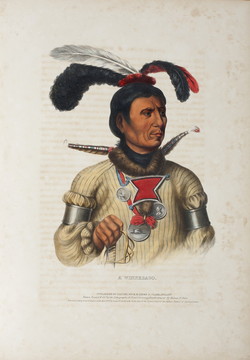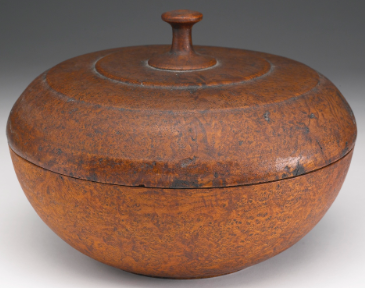 When one hears reference to McKenney and Hall, it is easy to assume, as it often the case with lithography, that they were the publishers or printers, but in reality, Thomas Loraine McKenney (1785 to 1857) and James Hall (1793 to 1868) played a much larger role in the portraits which would form the basis of the folio History of the Indian Tribes of North America. Philadelphia: 1837-1844.
When one hears reference to McKenney and Hall, it is easy to assume, as it often the case with lithography, that they were the publishers or printers, but in reality, Thomas Loraine McKenney (1785 to 1857) and James Hall (1793 to 1868) played a much larger role in the portraits which would form the basis of the folio History of the Indian Tribes of North America. Philadelphia: 1837-1844.
McKenney, initially Superintendent of Indian Trade and later heading up the Office of Indian Affairs, working as he did under Presidents Madison, Monroe, Adams, and Jackson, took a respectful and yet fatalistic view, it seems, of the American Indian peoples, as he seemed to feel it was necessary to preserve their tribal cultures, believing they were destined to be obliterated. Thus, as his work brought him into contact with the various tribal leaders who visited Washington over the years as members of treaty delegations, he began to commission their portraits.
Charles Bird King (1785 to 1862) did the vast majority of the portraits McKenney commissioned, although a number were also done by James Otto Lewis and George Cooke, and his sensitive, vibrant portraits are all the more remarkable when one realizes that King’s own father was scalped by Indians in 1789, when King was just four years old, after the family had traveled west to Ohio.
By the 1830s, after more than a decade of portraits, McKenney felt the collection, displayed in the War Office, needed a broader audience, but to complete such a project would require more effort and different skills than those he had to offer. As a result, he commissioned lithographs of the paintings and recruited James Hall, a frontier Renaissance man who worked as a lawyer, a judge, a newspaper editor and author, among other things, to pull together biographical sketches and appropriate text to accompany what McKenney envisioned as a three-volume set.
As was common in the era because of the associated costs, such sets were usually sold in advance on a subscription basis (this set was sold at $120), and while Hall powered through the work of sorting out very vague notes with murky references to individuals, they managed to sell enough subscriptions to begin. Timing was bad, however, and the Panic of 1837 dealt the project a near-mortal blow as many subscribers were left without the means to pay. Things became grim enough that McKenney actually abandoned the project he had begun, but Hall, who had by this time invested close to a decade in the work, persevered, recruited another publisher, and pushed on.
The final volume, by which time there were 1,250 subscribers, was not finished until 1844. In 1858, the original portraits were moved to The Castle, the Smithsonian’s first building, and they remained there until the winter of 1865, when they were to be relocated. The men charged with the work brought in a woodstove which they vented into a ventilation shaft they believed to be a flue. After several weeks, a fire started and despite fireproofing efforts in the building, the damage was extensive and the Castle’s roof collapsed. Only five of the original 300 portraits survived. (The fire also destroyed approximately 200 other paintings of Native Americans by John Mix Stanley and a great deal of important correspondence and paperwork.) It is only because of the foresight, awareness and persistence of Thomas McKenney and James Hall that these valuable images, with their detailed, colorful and accurate renderings of American Indian tribal dress and customs, survive for us today.
Complete sets can still be had for prices that can vary from $25,000 to $100,000, depending on condition and binding. (Subscription publications were bound by the individual subscribers, often coming in piecemeal over many months or years, and the quality of the bindings can vary widely from set to set.) An octavo set was published in the 1850s and it can be had for something closer to $10,000. Individual print prices are also affected by condition, of course, but the fame of the sitter and the drama of his costume are also important factors. Chief Red Jacket, for example, dressed in English-style clothes and wearing his enormous peace medal, often sells for more than $2,500, but lesser known chiefs’ images sell for $200-500.
![Pottery; San Ildefonso, Blackware, Bowl, Martinez (Maria), Avanyu Decoration, 10 inch. Maria Martinez San Ildefonso blackware [pottery] bowl, vasiform with high rounded shoulder gunmetal finish with [decoration of] Avanyu slithering along shoulder; signed Marie on base, circa 1925.](http://www.prices4antiques.com/item_images/medium/64/26/10-01.jpg) Avanyu (sometimes Awanyu) is a deity of the Tewa people. The Tewa are Pueblo Native Americans who share the Tewa language and live around the Rio Grande River north of Santa Fe, New Mexico among the pueblo communities of Nambé,
Avanyu (sometimes Awanyu) is a deity of the Tewa people. The Tewa are Pueblo Native Americans who share the Tewa language and live around the Rio Grande River north of Santa Fe, New Mexico among the pueblo communities of Nambé,






